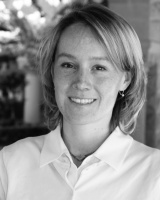Kate Maher

| Title: | Assistant Professor |
| Primary Affiliation: | Department of Geological & Environmental Sciences |
| Office Location: | Green Earth Sci. 221 |
| Research Group: | Environmental Isotope Geochemistry & Geochronology |
| Research Lab: | ICPMS/TIMS Shared Facility |
| Phone: | 650-725-0927 |
| E-mail: | kmaher@stanford.edu |
Research
Chemical reactions between fluids and minerals create the environments that are uniquely characteristic of Earth’s surface. For example, chemical weathering reactions support the growth of soils and organisms and regulate the flow of elements to the oceans. The rates of these reactions also control the release and storage of natural and human-derived contaminants. Over geologic timescales, mineral-fluid reactions have helped to maintain a mostly habitable planet. Over human timescales, these reactions will regulate our ability to use Earth’s resources, such as soils, waters, and minerals.
My research focuses on the rates of chemical reactions that occur at Earth’s surface and in the shallow subsurface. Because the rates of most mineral-fluid reactions are fairly slow, they control the transfer of elements between important reservoirs. In order to quantify the rates of chemical reactions and to determine how these rates vary in response to changes in hydrologic, chemical and biological parameters, I use a combination of geochemical tools including isotope geochemistry, geochemical modeling, and geochronology to address the following themes: (1) defining the controls on mineral-fluid reactions rates across a spectrum of environments from natural soils and sediments to geothermal systems; (2) finding new approaches to use mineral-fluid reactions to safely store carbon dioxide in the subsurface; and (3) development of isotopic approaches to study mineral-fluid reactions in the environments of Earth’s past. To support these research themes, I have constructed a new mass spectrometer and clean lab facility capable of high precision geochemical and isotopic measurements.
Teaching
My teaching focuses on introducing students to the questions and major challenges in low temperature and environmental geochemistry, and the application of isotope geochemistry to environmental and geologic problems. In order to introduce incoming students to Earth surface processes, materials and geochemistry, I am also teaching a freshman seminar on forensic geology. At the graduate level, I offer classes on isotope geochemistry and numerical modeling of environmental transformations and mass transport processes.
Professional Activities
2011:
Invited Lectures: Yale University, UC Berkeley
Invited Abstracts: Goldschmidt Conference, Prague, Czech Republic
2010:
Keynote Speaker, Goldschmidt Conference, Knoxville, TN
Co-instructor of 2-day short course on reactive transport modeling using The Geochemist’s Workbench® with Craig Bethke, Stanford, CA
Invited Lectures: California Institute of Technology, UCLA, Boston University, Rice University
Invited Abstracts: American Geophysical Union Fall Meeting, San Francisco, CA; Geological Society of America Conference, Denver, CO
2009:
Associate Editor, American Journal of Science (appointed through 2013)
Co-editor: “Combined ecological and geologic perspectives in ecosystem studies”, Chemical Geology (Special Volume)
Invited Participant: “Critical Zone II: Biological Aspects of Weathering”, Washington, DC
Participant, DUSEL (Deep Underground Science and Engineering Laboratory) Experimental Coordination Workshop, Lead, SD
Member, DUSEL Experimental Design Team (THMCB)
Symposium Chair, Goldschmidt Conference: “Bridging the gap between theory and the field in critical zone processes”
Invited Lectures: Duke University, UC Davis, U. of Delaware,
Invited Abstracts: American Geophysical Union (AGU) Fall Meeting, San Francisco, CA

Facebook
iTunes U
Twitter
YouTube